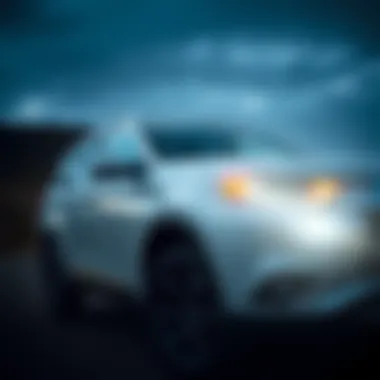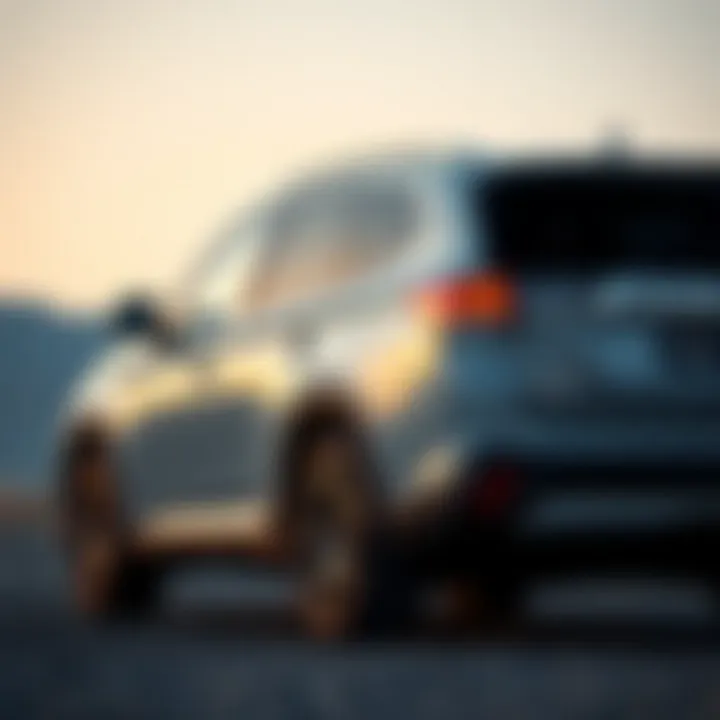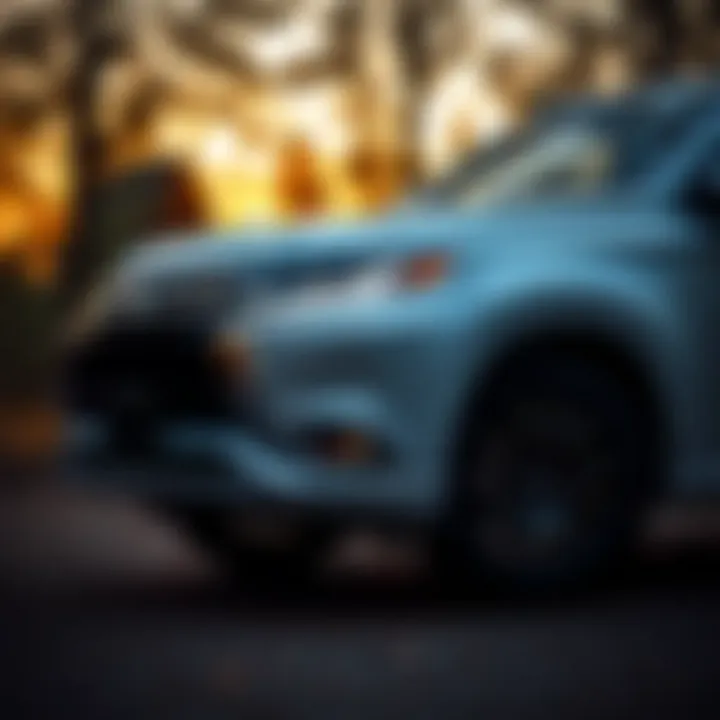In-Depth Reviews of Mitsubishi Outlander SUVs


Intro
As the automotive landscape continuously evolves, the competition among SUVs is fierce. Among the key contenders in this arena is Mitsubishi's Outlander, a vehicle that has made a name for itself over the years. While many SUVs offer versatility and capacity, the Outlander distinguishes itself through a blend of practicality, comfort, and an impressive array of features. This comprehensive exploration of the Outlander SUVs is intended not only for prospective buyers but also for automotive aficionados seeking insight into the latest trends in the market.
Through careful examination of performance metrics, features, and customer satisfaction, this article aims to paint a clear picture of what one can expect from the Outlander range. We will dissect expert reviews, integrate user feedback, and compare various models, ensuring that readers are well-equipped to make an informed decision. In an age where consumer choices are influenced by both performance and personal preferences, understanding the intricacies of the Outlander lineup will pave the way for smarter purchases.
Let’s dive into
Performance Metrics
When assessing any SUV, performance is a central piece of the puzzle. This section breaks down the critical performance aspects of the Outlander SUV, helping you understand where it excels and where it might not hit the mark.
Fuel Efficiency
Fuel efficiency remains a priority for drivers, especially in today’s economic landscape. The Mitsubishi Outlander presents a competitive offering with its fuel-sipping capabilities. Models equipped with the 2.4-liter engine average around 30 miles per gallon on the highway, a figure that many in the compact SUV category would envy. In city driving, this number drops slightly but still hovers around 25 miles per gallon, making it a solid choice for urban dwellers. However, the hybrid variant of the Outlander takes things a step further, with an impressive MPG rating that straddles the line between performance and eco-friendliness.
"Fuel efficiency isn't just about savings at the pump; it’s a reflection of how a vehicle fits into your lifestyle considerations."
Handling and Stability
With handling, the Outlander does deliver a comfortable ride, though it isn’t particularly sporty. The steering provides ample feedback, and the SUV feels planted on the road, even when tackling sharper turns. The suspension absorbs bumps effectively, ensuring that both driver and passengers experience minimal discomfort. Nevertheless, keep in mind that those who prioritize a sportier experience may find the Outlander's dynamics a bit tame in comparison to rivals.
In terms of stability, the Outlander boasts all-wheel drive options that enhance traction. This feature is especially useful in slippery conditions, increasing driver confidence whether you are navigating through rain or light snow. It’s clear that Mitsubishi aimed to provide a sensible balance between comfort and capability.
As we wrap up our analysis of performance metrics, it's crucial to understand that these figures represent a broader goal: meeting the expectations of varied consumers—urban drivers, families, and outdoor enthusiasts alike.
Car vs Boat Considerations
The automotive market can change at the drop of a hat. Thus, looking beyond mere specifications can illustrate trends that inform purchasing decisions. This segment dives into broader considerations while looking specifically at Mitsubishi’s reputation and retention within the industry.
Value Retention and Depreciation
When investing in a vehicle, understanding its value retention is key. Outlanders typically hold their value relatively well in the market, a significant factor if you plan to resell in the future. On a larger scale, vehicles from Mitsubishi tend to depreciate at a slower rate compared to their European counterparts. A study published by Edmunds shows that average SUVs retain roughly 40% of their value after three years, while various Outlander models do better than this average, appealing to cost-conscious buyers.
Manufacturer Reputation Analysis
Mitsubishi has had its ups and downs in terms of brand perception, but it's no stranger to the automotive world. A long-standing history, coupled with a reputation for reliability, gives the Outlander a sturdy foundation. Consumer Reports and J.D. Power rankings often highlight the Outlander as a dependable option, signifying that owners generally report high satisfaction levels post-purchase. However, like any manufacturer, there are blemishes on Brand Mitsubishi’s reputation; some owners cite underwhelming customer service experiences. This dichotomy speaks volumes about the importance of thorough research before making a purchase.
As we transition through our analysis, the focus remains on providing valuable insights to help consumers navigate the complexities of the Outlander SUV options. This comprehensive review aims to synthesize the discussions, giving readers the knowledge they need to make educated decisions.
Preamble to Outlander SUVs
The topic of Outlander SUVs holds substantial weight in today’s automotive discussions, especially as interest in versatile and family-oriented vehicles continues to grow. Outlander's unique proposition includes a blend of comfort, performance, and technology, making it a compelling option for various drivers.
When considering a new SUV, it's vital to understand not just its specifications but also its historical evolution, current relevance in the market, and how it measures against competitors. This article aims to dissect these aspects in detail, helping readers navigate their choices amidst a sea of options. Emphasizing the importance of informed decisions, this discussion of Outlander SUVs will delve into crucial elements such as:
- Performance metrics that speak to how the vehicle handles on the road.
- Functional comforts that improve the driving experience for both drivers and passengers.
- Technological advancements that position the Outlander as a modern contender in the SUV arena.
Supporting this narrative will also be insights from users and industry analysis, equipping potential buyers with a holistic understanding.
Historical Background
The Outlander brand has a rich history intertwined with the evolution of the SUV market. Launched by Mitsubishi in 2001, the Outlander debuted as a compact SUV aimed at capturing a diverse audience’s attention. Through the years, it underwent several changes, reflecting automotive trends and consumer desires. From the early 2000s, when SUVs were primarily utility vehicles, to today, where functionality meets sophistication, the Outlander has adjusted its design and performance characteristics to fit the times.
In the third generation, which came around 2012, Mitsubishi focused on family needs by incorporating more safety features and onboard technologies. This shift helped to propel the Outlander into a new standard for SUVs, making it suitable for daily commutes as well as family road trips.
As competitors rolled out advanced models, Mitsubishi's strategic revisions ensured that the Outlander remained relevant amid a rapidly changing landscape.
Current Market Position
Today, the Outlander stands at a crossroads in the competitive SUV market. Positioning itself as a mid-range option, it caters to a demographic that values affordability without compromise. It's not a luxury model, but it has enough features to satisfy consumers looking for both style and function.
In the United States, for instance, the Outlander consistently ranks among the top-selling SUVs in its class. Car buyers often view it as a budget-friendly alternative to more expensive options, while still offering tech features that resonate with a modern audience.
Today’s market focuses heavily on fuel economy, adaptability, and ecological considerations. As such, Mitsubishi has put emphasis on hybrid versions of the Outlander, making strides in reducing emissions and aligning with sustainability trends that consumers increasingly seek.
In summary, the Outlander SUV, with its combination of historical resilience and current relevance, is more than just a family car—it's a model evolving to meet consumer expectations and market pressures. This article will elaborate on its features, performance, and how it stacks up against the competition.
Overview of the Outlander Model Range
Understanding the Outlander model range is crucial for anyone considering an SUV in today’s bustling automotive market. Mitsubishi launched the Outlander line as a versatile and family-friendly vehicle, capturing the attention of drivers seeking practicality without sacrificing style. The significance of this review lies in delineating various models, uncovering their specifications, and evaluating how they stack up against one another.
The Outlander series is designed with different needs in mind. From urban commuting to weekend getaways, the models possess distinct advantages that cater to a broad audience. For anyone thinking about buying, a clear grasp of this model range allows for informed decision-making, ensuring that you're not just buying a vehicle, but investing in a lifestyle.
Detailed Specifications
Delving into the specifications of the Outlander models reveals a tapestry of engineering and design. The range includes various trims, each boasting unique features that can make a world of difference in the driving experience.
- Engine Options: The Outlander offers various engines, such as the lively 2.5-liter inline-four and the more powerful V6 variant. Each delivers a tailored performance profile that aligns with diverse driving preferences.
- Capacity and Dimensions: The interior space stands out with seating for up to seven passengers. This seating arrangement is complemented by a generous cargo area that can handle everything from groceries to sporting equipment.
- Towing Capabilities: Whether it's for a boat or a trailer, the Outlander's tow capacity is worth noting. Depending on the model, it can tow between 1,500 to 3,500 pounds, making it versatile for recreational activities.
Each specification plays a vital role in how these vehicles perform and meet buyer expectations. The complexity of choices available adds to the allure of the Outlander SUVs as potential buyers can tailor their selections to fit their lifestyles.


Comparative Analysis of Models
A comparative analysis of the various Outlander models surfaces the strengths and weaknesses inherent to each trim. This section is pivotal for prospective buyers who are evaluating which model best fits their needs.
Main Models to Consider:
- Outlander SE: This model tends to attract families with its robust safety features and spaciousness, all while remaining budget-friendly.
- Outlander Sport: Known for its nimble handling and compact size, it appeals to urban drivers and those who might prefer a slightly smaller SUV experience.
- Outlander PHEV: The plug-in hybrid variant stands out as environmentally conscious, combining electric efficiency with traditional gasoline power. This model is perfect for eco-minded consumers who seek to minimize their carbon footprint.
Key factors for comparison often include:
- Pricing: Models can vary significantly in cost, providing options across different financial ranges.
- Features: Advanced driver-assistance systems, infotainment options, and comfort features differ across models, influencing overall value.
- Driving Dynamics: Evaluating how each model handles on the road uncovers insights that are often only fully understood through hands-on experience.
"Choosing the right Outlander model can feel like picking a favorite child; each has its own strengths, making it difficult but essential to select based on your specific needs."
As such, this comparative landscape draws potential buyers into a thoughtful consideration process, encouraging them to weigh their priorities against the distinct offerings of each model. With these insights, navigating the Outlander range becomes less daunting and more empowering.
Performance Analysis
Performance Analysis holds significant weight when evaluating the Outlander SUV range as it directly influences driving experience, owner satisfaction, and vehicle longevity. In a world where consumers seek reliability and efficiency, understanding the technical specifications and performance metrics is crucial. Whether it's the thrill of acceleration, handling during tricky road conditions, or simply the peace of mind when it comes to fuel consumption, every aspect intertwines to create a comprehensive picture that potential buyers need.
This section delves into the engine options available for the Outlander SUVs, explores the effectiveness of different transmission capabilities, and breaks down the fuel efficiency metrics that play a vital role in consumer decision-making.
Engine Options
Engine options in the Outlander lineup are designed to cater to a diverse audience. From efficient four-cylinder engines to robust V6s, each variant offers a distinct feel on the road. The base models typically feature a 2.4-liter four-cylinder engine, which balances power and fuel economy quite well. Meanwhile, higher trims may come equipped with a 3.0-liter V6 engine, offering additional horsepower when needed, particularly for drivers who may require towing capabilities for outdoor adventures.
- 2.4-liter Four-cylinder Engine: Known for its understated yet reliable performance. It provides a solid 166 horsepower and offers decent torque that aids in everyday driving needs.
- 3.0-liter V6 Engine: This variant ups the ante considerably, boasting around 224 horsepower, making it suitable for those seeking a more dynamic driving experience.
When considering engine options, it’s crucial to think about how you'll use the vehicle. For city driving and short commutes, the four-cylinder might be sufficient; however, if you're looking to navigate mountainous terrain or carry extra weight, the V6 could be more appropriate.
Transmission Capabilities
Transmission options also play a key role in how the Outlander performs under various conditions. The standard car comes with a continuously variable transmission (CVT) that enhances fuel efficiency while offering smooth acceleration. This feature is increasingly popular in modern SUVs as it optimizes engine output to varying driving conditions.
Drivers looking for a responsive feel may appreciate the shifting options available in higher trims, which may include paddle shifters, giving that sporty edge to the driving experience. Here’s a quick look at what various transmission systems offer:
- Continuously Variable Transmission (CVT): This tech continuously adjusts engine power delivery, providing seamless transitions without the distinct shifts found in traditional automatics. A smooth ride is a hallmark of CVTs.
- 6-Speed Automatic Transmission: Available in sporty models, this option can provide a more engaging driving experience which some may find more familiar.
Fuel Efficiency Metrics
Fuel efficiency emerges as a critical factor for buyers mindful of cost-effectiveness and environmental impact. The Outlander models generally do well in this department, with the four-cylinder version attracting attention for its frugality.
Typically, the four-cylinder option earns around 30 miles per gallon on the highway, while the V6 can consume more fuel, clocking in at about 25 miles per gallon at best. Understanding these metrics helps buyers gauge whether they can manage their fuel costs effectively without compromising on other vehicle attributes.
“When purchasing a vehicle, it’s wise to consider not just the upfront cost but also how those engine and transmission choices will affect long-term savings at the pump.”
While the Outlander offers competitive fuel efficiency, how each driver intends to operate the vehicle should influence their choice of engine and transmission. In short, performance analysis transcends mere numbers; it’s about aligning the specs with user needs.
Interior Features and Comfort
When delving into the world of Outlander SUVs, the discussion about interior features and comfort cannot be overlooked. An SUV serves not only as a means of transportation but also as a mobile sanctuary for many. With extended journeys becoming a norm for families and adventurers alike, these vehicles need to prioritize interior comfort and advanced features.
Specific elements such as seating layout, infotainment systems, and abundant cargo space all play crucial roles in enhancing the driving experience. Thus, evaluating these components offers insights into what potential buyers can realistically expect, ensuring they’re equipped to weigh their options accordingly.
Seating Arrangements
A comfortable seating arrangement is at the heart of any vehicle's interior design. In the Outlander, you'll notice the flexibility offered by its seating configurations. With options to accommodate seven passengers or convert seats to create more storage space, it provides a balance between passenger and cargo needs. The standard seating layout features high-quality upholstery that feels both durable and soft against the skin, which is a minor yet significant aspect to keep in mind, especially on long travels.
Additionally, features such as reclining rear seats and adjustable front seating positions allow drivers and passengers to find their perfect comfort zone.
- Pros of Outlander Seating:
- High-quality materials ensure durability.
- Versatile configurations for different needs.
- Ability to accommodate various passenger sizes comfortably.
Infotainment Systems
A key component of contemporary SUVs is the infotainment systems. The Outlander showcases an intuitive touchscreen interface that merges convenience with functionality. Its layout minimizes the learning curve for new users, helping them access navigation, entertainment, and connectivity options. For example, this system allows for smartphone integration via Apple CarPlay and Android Auto, essential for tech-savvy consumers who rely on their devices.
Don't ignore the sound system either; the available upgraded audio packages can add a bespoke touch to the driving experience, pleasing audiophiles among prospective owners. It's these tech offerings that ensure that the Outlander is not just about getting from point A to B but making the journey enjoyable along the way.
- Featured Benefits:
- User-friendly interface ensures a smooth experience.
- Smartphone integration keeps drivers connected.
- Enhanced audio options cater to music lovers.
Cargo Space Considerations
The Outlander scores big when you look at cargo space. It can be a headache if you're juggling family trips or moving gear for outdoor activities, and insufficient cargo space can quickly turn your plans into chaos. The Outlander's trunk capacity is impressive, especially when the third-row seating is folded down.
In these scenarios, you'll marvel at how much room you've got to work with. This versatility extends to additional storage compartments designed throughout the vehicle. For instance, the compartment beneath the floor is a handy spot for stashing less frequently needed items. Such thoughtful design enhances the practical use of the space available, appealing to those who require a vehicle ready to handle daily tasks alongside adventurous spirit.
- Cargo Space Advantages:


- Flexible arrangements to suit cargo needs.
- Underfloor compartments for added storage.
- Ample trunk capacity when seats are down.
As you consider the Outlander, remember that its interior is designed with you in mind—balancing style, technology, and utility.
Safety Features and Ratings
Safety has become a paramount concern for consumers when purchasing an SUV. With the Outlander range, buyers are not only looking for style and performance, but they also want peace of mind knowing that they’re protected on the road. Safety features and ratings reflect a vehicle's ability to keep its occupants safe in the event of an accident, as well as its overall design integrity. Therefore, it is crucial to analyze these aspects thoroughly.
Standard Safety Technologies
The Outlander SUVs come equipped with a plethora of standard safety technologies that can turn a standard drive into a safe journey. Adaptive Cruise Control, Lane Departure Warning, and Automatic Emergency Braking are just a few of the advanced features available. These technologies not only alert the driver to potential hazards but also actively assist in avoiding accidents.
- The Adaptive Cruise Control ensures that the vehicle maintains a safe distance from others by adjusting speed automatically. This feature can be especially valuable during long drives on busy highways.
- Lane Departure Warning gives audible and visible alerts if the vehicle starts to drift out of its lane, aiding drivers in maintaining control.
- Automatic Emergency Braking can detect obstacles in the road and apply brakes if the driver does not respond in time, potentially averting an accident.
These features show that safety isn't just a checkbox for the Outlander but rather a comprehensive system designed to support everyday drivers. With modern distractions and busy roadways, having a robust suite of standard safety technologies can make a world of difference. Each of these technologies harmonizes to create a layered defense, boosting confidence behind the wheel.
Crash Test Ratings
Crash test ratings offer a bird's eye view of how well a vehicle performs under duress, evaluated through systematic and rigorously controlled situations. Organizations like the National Highway Traffic Safety Administration and the Insurance Institute for Highway Safety release their findings on how vehicles withstand various crash scenarios. The Outlander consistently scores well in these evaluations, reflecting its solid build and safety features.
For instance, Outlanders have often received a 5-star rating from the NHTSA, showcasing their capability to protect passengers in frontal, side, and rollover crashes. Here’s a brief breakdown of some findings:
- Frontal Crash Test: Demonstrates how well the vehicle protects occupants in head-on collisions.
- Side Crash Test: Evaluates safety for passengers when hit from the side, which is crucial for urban driving.
- Rollover Resistance: Shows how likely the vehicle is to roll over in extreme driving conditions.
"Knowing that a vehicle is engineered to withstand the toughest situations allows drivers to focus on the road and not worry about unforeseen events."
This detailed assessment assures potential buyers of the Outlander's positioning in the SUV segment as a strong candidate for safety-conscious families and adventurous individuals alike. The summed-up insights from both standard safety technologies and crash test ratings portray the Outlander not just as a reliable SUV, but as a partner on the road equipped to deal with the unpredictable twists and turns of driving.
Customer Feedback and Experiences
Customer feedback serves as a crucial barometer in understanding the real-world performance and practicality of Outlander SUVs. This section digs into the subjective experiences of drivers and families who use these vehicles day in and day out. With extensive discussions about their likes and dislikes, including the positives and the negatives of their journeys behind the wheel, it becomes evident why this topic matters so much in the realm of automotive reviews. Insights gathered from clients can shed light on less-known issues, thus offering a fuller picture beyond what manufacturers publicly announce.
The importance of customer feedback lies in its authenticity. Unlike expert reviews, which may be influenced by sponsorship or industry biases, user experiences present a grassroots perspective. These testimonials reflect genuine usage, covering everything from daily commutes to family road trips. By examining both praise and complaints, potential buyers can grasp the overall satisfaction level and potential pitfalls associated with the vehicle. This helps them make informed purchases, enhancing the likelihood of a misbuy.
Positive User Reviews
Many Outlander owners rave about their vehicles, particularly valuing their spacious interiors and comfortable rides. One standout point often mentioned is the expansive legroom, appealing to families who need space for kids and pets alike. The third-row seating is a notable feature in reviews, allowing for optional additional passengers when necessary.
Additionally, users frequently highlight the impressive tech features integrated into the vehicles. The infotainment system, which includes Apple CarPlay and Android Auto, receives favorable mention, especially for its ease of use and intuitive design. Another shining aspect of the Outlander SUVs is their safety ratings, with users often stating that they feel secure, thanks to the numerous safety technologies, such as lane assist and adaptive cruise control.
The overall fuel efficiency tends to be well-received as well. Many drivers express satisfaction with the balance between power and efficiency, particularly in the hybrid models, which are increasingly sought after in today's market.
"Driving my Outlander feels like navigating in a fortress. I appreciate the safety during those long-distance travels," a satisfied customer from Reddit notes.
Common Complaints
However, no car is without its flaws, and Outlander SUVs are no exception. While many reviews express satisfaction, several drivers voice challenges as well. One prevailing complaint pertains to the engine performance, as some users feel the powertrains could use an upgrade for smoother acceleration. This sentiment is echoed by commuters who often face highway merging situations.
Customers also report issues with the infotainment system, mentioning glitches or slow responses on occasion. Although beloved, the features can sometimes feel like a double-edged sword in terms of reliability, leaving some drivers frustrated in crucial situations.
Concerns about the cost of maintenance or repairs tend to come up too. A few users mention that while the Outlander may have an appealing price point initially, the long-term costs can be a shocker. Warranties cover many repairs, but as with any vehicle, there's a genuine worry about what lies ahead post-warranty.
In summary, customer feedback on Outlander SUVs presents a mixed bag of experiences. It underscores the SUV's strengths, like interior space and safety features, while also highlighting areas needing improvement, such as engine response and tech reliability. This duality helps potential buyers approach their decision with a more nuanced perspective.
Value for Money
When considering any vehicle, particularly SUVs like the Outlander, the concept of value for money can't be overlooked. It serves as a litmus test for buyers, guiding them to determine whether they're getting their money's worth in terms of features, performance, and overall satisfaction. A good understanding of value for money enables potential owners to weigh options effectively against their budgetary constraints and personal needs.
This section will delve into several essential facets of value for money, particularly focusing on how the Outlander SUV holds up in comparison to others in its class.
Pricing Analysis
In the current automotive landscape, the price tag on a vehicle is one of the first things prospective buyers gauge. The Outlander SUVs position themselves competitively within the market, providing a range of options that cater to diverse budgets. Starting prices typically hover around the mid-$20,000 range, making it accessible for average consumers, yet still offering premium features that appeal to the more discerning buyer.
Some of the Outlander models, such as the Outlander Sport and the Outlander PHEV, stand out with their pricing structure, especially when promotions or incentives kick in. This range allows buyers to evaluate their priorities—be it ample cargo room, advanced tech features, or fuel efficiency.
It's also critical to consider ongoing costs—fuel, insurance, maintenance—these influence the overall value proposition. A vehicle might have a low purchase price, but higher long-term expenses can negate any initial savings. The Outlander typically showcases lower insurance costs and decent fuel efficiency, bolstering its value for buyers when compared to rivals that may surprise with hidden costs.
"Value for money isn't just about what you spend today, but what you save over time."
Comparative Value in SUV Segment
Peering into how the Outlander stacks against its competition reveals varying metrics of value. When compared to other SUVs like the Honda CR-V or Toyota RAV4, the Outlander often comes out with features that rival, if not surpass, those offered by more established brands. Many consumers report that the included warranty options provide peace of mind often lacking in other vehicles in the same price bracket, making it a compelling choice for families or long-distance commuters.
- Feature Set Comparisons: Unlike some competitors that offer basic models, the Outlander provides a comprehensive set of standard features, inclusive of advanced safety technologies, a robust infotainment system, and versatile seating configurations.
- Resale Value Considerations: Resale value can also tip the scales of value for money. While Outlanders may not carry the same resale demand as some competitors, the depreciation rates remain relatively moderate, which is reassuring for buyers who plan to upgrade down the road.
In summary, buyers assessing value for money in the Outlander SUVs will find a reasonable blend of initial purchase price, standard features, and long-term expenses. The balance achieved by Mitsubishi in ensuring that the investment caters to both quality and affordability makes the Outlander a noteworthy contender in the competitive SUV market.
Environmental Impact
The topic of environmental impact holds a significant weight in discussions surrounding Outlander SUVs, especially in today's world where much emphasis is placed on sustainability and eco-friendly practices. As we dive into the specific aspects of this segment, let's explore emissions statistics and sustainability initiatives that define the environmental footprint of these vehicles.


Emissions Statistics
With emissions from vehicles contributing heavily to global warming, the statistics connected to Outlander SUVs warrant a closer look. Mitsubishi has made strides in minimizing the output of harmful emissions from their models. Recent figures suggest that the Outlander series maintains lower CO2 emissions compared to many rivals in the same class. For instance, the Outlander PHEV (Plug-in Hybrid Electric Vehicle) provides an attractive alternative with emissions as low as 46 g/km, showcasing its efficiency in tackling air pollution concerns and supporting cleaner urban environments.
"Every gram counts in the emissions game, and the Outlander is carving a path towards less impactful transportation solutions." - An industry expert
Moreover, the internal combustion models of the Outlander have improved on fuel efficiency metrics, which directly correlates to emission outputs. Statistics reveal better performance over previous models, giving consumers more choices that align with their values of eco-responsibility. This information is crucial for buyers, especially those concerned with which SUVs make a positive impact on our planet.
Sustainability Initiatives
In the quest for greener practices, Mitsubishi has not only focused on reducing emissions but also introduced various sustainability initiatives surrounding their vehicle production and lifecycle. One prominent initiative is their commitment to renewable energy sources during manufacturing. The production facilities are gradually transitioning to wind energy and solar power, significantly cutting down the carbon footprint associated with vehicle assembly.
Another expectation from modern consumers is the recyclability of materials used in vehicle manufacturing. Mitsubishi emphasizes the use of recyclable plastics and eco-friendly materials in the Outlander SUVs, ultimately aiming for a circular economy where materials are reused rather than disposed of. This initiative aligns with wider industry practices that aim to minimize waste and maximize resource efficiency.
Additionally, the company’s approach to hybrid technology contributes to less reliance on fossil fuels, promoting a smoother transition towards electric mobility. With plans to expand EV options in their lineup, Mitsubishi shows foresight in responding to market demands and environmental necessities.
In essence, as the Outlander SUVs suggestively align their design and development to address environmental concerns, they embody a holistic approach for sustainable urban mobility, and potential buyers should weigh these factors heavily in their purchase decisions.
Comparative Analysis with Competitors
In the competitive landscape of SUVs, a thorough comparative analysis with competitors is not just beneficial but essential for any potential buyer. This aspect of our review of Outlander SUVs delves into how these models stand against rivals in the market. Understanding the strengths and weaknesses of competitors helps consumers make informed decisions regarding their investments. This section aims to illuminate critical elements that differentiate Outlander SUVs from others in its class, ultimately enhancing the purchasing experience.
Performance Against Rivals
When it comes to performance, Outlander SUVs present a robust argument for their place in the market. In comparison with competitors like the Honda CR-V and Toyota RAV4, Outlander models demonstrate a fine balance of power and efficiency.
Key considerations when evaluating performance include:
- Engine Power: The Outlander often employs a powerful V6 engine that can compete well against turbocharged alternatives from competitors. This results in a pleasing acceleration, which is especially noticeable during merging on highways or navigating steep inclines.
- Handling and Drive Experience: While some rivals may offer sporty performance, Outlander models provide a more balanced driving experience that has been noted for comfort and composure. The smooth ride quality is particularly appreciated during long journeys.
- Off-Road Capabilities: The availability of all-wheel drive further enhances the Outlander’s versatility, allowing it to handle various terrains effectively, often outperforming front-wheel-drive only competitors under adverse conditions.
Ultimately, the silkiness of the Outlander's performance engine combined with its robust build positions it as a competent contender in the face of challenges from other brands.
Market Trends and Insights
In today's rapidly changing automotive market, understanding trends can significantly influence buying decisions. For Outlander SUVs, keeping a finger on the pulse of the market helps elucidate their positioning compared to competitors.
Recent insights reveal several notable trends affecting SUVs:
- Consumer Demand for Fuel-Efficiency: As fuel prices fluctuate, manufacturers are increasingly focusing on hybrids and more energy-efficient engines. Outlander models, with their relatively good fuel economy, represent a viable option.
- Shift towards Advanced Tech Features: Modern consumers gravitate towards vehicles loaded with technological advancements such as driver-assist features and smart infotainment systems. The Outlander’s offerings in this area have been evolving to compete with tech-laden competitors.
- Sustainability Concerns: With a growing number of buyers expressing interest in environmental impacts, Outlander has taken steps towards sustainability while still maintaining performance, something that resonates with conscious consumers.
These trends not only inform potential buyers but also compel manufacturers like Mitsubishi to evaluate and adapt their strategies continuously, ensuring that Outlander SUVs stay relevant and appealing in an ever-evolving marketplace.
The automotive landscape is like a race; only those who continuously innovate and adapt will find lasting success.
Through understanding how the Outlander compares to rivals and recognizing market shifts, buyers are well equipped to make informed decisions, thereby enhancing their overall investment in an SUV.
Future of Outlander SUVs
The future of Outlander SUVs stands at a pivotal crossroads, marked by significant changes in consumer preferences, advancements in technology, and shifting market dynamics. As potential buyers increasingly prioritize not just capability but also sustainability and innovation, manufacturers must adapt quickly to remain competitive. This section dives deep into what lies ahead for the Outlander lineup, exploring both the imminent innovations in model design and the broader trends influencing the SUV market.
Understanding the future trajectory of Outlander SUVs is essential for enthusiasts and consumers alike. Not only does it inform purchasing decisions, but it also reflects the changing landscape of the automotive industry. Key pieces of this puzzle include the anticipated technological advancements and consumer demands that will shape these vehicles in coming years.
Upcoming Model Innovations
Mitsubishi is keen on keeping the Outlander lineup fresh and appealing. In upcoming models, we can expect a plethora of innovative features designed to enhance the driver and passenger experience. Below are some anticipated innovations:
- Hybrid and Electric Variants: As the push for greener vehicles intensifies, hybrid and electric versions of the Outlander are becoming increasingly vital. Early models are rumored to incorporate advanced powertrains, offering better fuel efficiency and reduced emissions.
- Tech-Driven Features: Cutting-edge technology such as augmented reality displays and AI-driven driving aids will likely be part of the next-generation Outlanders. These innovations may provide drivers with real-time navigation data and vehicle health monitoring.
- Smart Cabin Experience: Mitsubishi might amplify its focus on in-car entertainment and connectivity. Expect features such as enhanced voice recognition systems and seamless smartphone integration to improve ease-of-use in navigation and media consumption.
- Enhanced Safety Features: Safety tech never goes out of style. Innovations like advanced collision avoidance systems and 360-degree cameras could soon be standard in new models, ensuring that safety remains a top priority.
"In the fast-paced world of automotive innovation, staying ahead means not only keeping up with trends but also anticipating consumers' needs and desires."
Predicted Market Trends
The SUV market is undergoing transformations that could influence the Outlander line significantly. Here are some key trends to watch:
- Emphasis on Sustainability: Consumers are increasingly favoring environmentally friendly options. This trend is not just a fad; it's a profound shift towards electric and hybrid models. Outlander SUV’s appeal could grow if Mitsubishi focuses more on sustainability.
- Technological Integration: As we move further into the digital age, tech-savvy consumers expect convenience. Features like over-the-air updates, digital dashboards, and intuitive infotainment systems will become essential for keeping pace with competitors.
- Lifestyle-Centric Designs: Upcoming Outlander models may embrace more versatile features. Young families and adventure seekers need flexible use of space, so more functional interiors and configurable cargo options will be key selling points.
- Consumer Experience: The decision-making process is gradually shifting from traditional methods to online research. Therefore, providing detailed reviews and virtual tours online will enhance customer engagement, playing into Mitsubishi's hands if they adopt this strategy.
As the landscape evolves, Mitsubishi's engagement with these trends will likely define the future of Outlander SUVs.
In summary, the future of Outlander SUVs appears to be bright, but it hinges on the manufacturer's ability to adapt to rapid changes in both technology and consumer expectations.
Finale
The conclusion of this article serves as a critical juncture, summarizing the extensive analysis provided on the Outlander SUVs. It encapsulates the insights gleaned from various evaluations, both expert opinions and user experiences, offering a holistic view of what these vehicles have to offer. As one surveys the breadth of features, performance metrics, safety ratings, and customer feedback, it's clear that choosing the right SUV involves more than just a quick glance at specifications. The relevance of this conclusion lies in its potential to inform prospective buyers about what to expect when investing in an Outlander.
Summary of Insights
In the exploration of Outlander SUVs, several key themes emerged:
- Performance: The Outlander showcases a variety of engine options and refined transmission capabilities that cater to diverse driving preferences.
- Safety: With robust safety technologies and respectable crash test ratings, these models provide peace of mind for drivers and families alike.
- Interior Comfort: Features such as spacious seating arrangements and intuitive infotainment systems contribute to a pleasant driving experience.
- Value Proposition: When compared to competitors, the Outlander exhibits a commendable balance of price and features, proving its worth in the crowded SUV market.
These insights direct potential buyers toward informed decisions, steering clear of mere marketing gimmicks and toward vehicles that truly deliver on performance and value.
Final Recommendations
For those contemplating the purchase of an Outlander SUV, a few recommendations emerge from the analysis:
- Test Drive: Before making a final decision, it's prudent to book a test drive. This firsthand experience can reveal much about the vehicle's handling, comfort, and overall feel.
- Consider Your Needs: Evaluate what you need most from a vehicle. If family transport is a priority, the Outlander’s spacious interior may be key. For those focused on fuel efficiency, the hybrid option could prove beneficial.
- Stay Informed on Reviews: Continually check for updates on customer feedback as new models are released, as this can influence resale value and satisfaction levels in the long run.
- Explore Trim Levels: Different trim options offer various features. Assess which conveniences and technology suit your lifestyle best.
In closing, the decision to purchase an Outlander SUV hinges on careful consideration of the discussed factors, ensuring that buyers make choices aligned with their needs and preferences. The analysis in this article serves as a comprehensive guide to navigating that decision.



